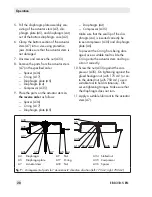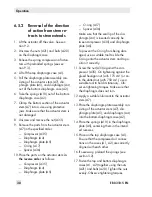
36
EB 8310-5 EN
Servicing
To prevent the O-ring from being dam-
aged, use a suitable tool to slide the
O-ring onto the actuator stem and to po-
sition it correctly.
10. Screw the nut (A33) against the com-
pressor (A35). On tightening against the
glued hexagon nut (with 175 cm²) or on-
to the slotted nut (with 750 cm²), use a
suitable tool to hold it stationary. Ob-
serve tightening torques. Make sure that
the diaphragm does not turn.
11. Apply a suitable lubricant to the actuator
stem (A7).
12. Place the diaphragm plate assembly con-
sisting of the actuator stem (A7), dia-
phragm plate (A5), and diaphragm (A4)
into the bottom diaphragm case (A2).
13. Place the springs (A10) in the diaphragm
plate (A5), centering them in the intend-
ed recesses.
14. Place on the top diaphragm case (A1).
Ensure that the compressed air connec-
tions on the cases (A1, A2) are correctly
aligned with each other.
15. If necessary, preload the springs (see
section 5.2).
16. Fasten the top and bottom diaphragm
cases (A1, A2) together using the nuts
(A21) and bolts (A20). Tighten the nuts
evenly. Observe tightening torques.
17. Mount the actuator on the valve (see sec-
tion 5.1).
Version with direction of action "actuator
stem retracts" (FE)
1. Lift the actuator off the valve. See sec-
tion 9.2.
2. Unscrew the nuts (A21) and bolts (A20)
on the diaphragm case.
A7
A4
A36
A33
A9
A35
A5
A17
A36
A33
A7
A17
A35
A4
A5
A34
A4
Diaphragm
A5
Diaphragm plate
A7
Actuator stem
A9
Nut
A17 O-ring
A33 Nut
A34 Slotted nut
A35 Compressor
A36 Spacer
Fig. 12:
Arrangement of parts for "stem retracts" direction of action (left: 175 cm²; right: 750 cm²)
Содержание 3277
Страница 46: ...46 EB 8310 5 EN...
Страница 47: ...EB 8310 5 EN 47...













































